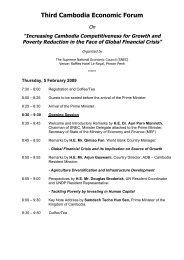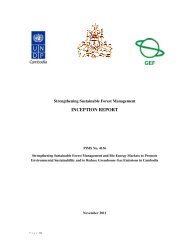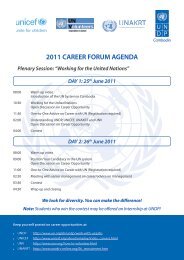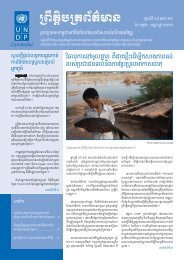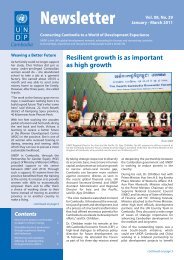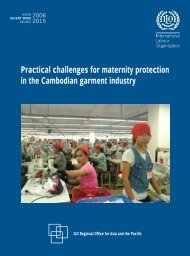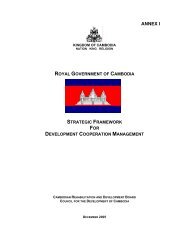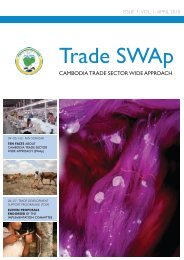UN Analysis Final.pdf - United Nations in Cambodia
UN Analysis Final.pdf - United Nations in Cambodia
UN Analysis Final.pdf - United Nations in Cambodia
You also want an ePaper? Increase the reach of your titles
YUMPU automatically turns print PDFs into web optimized ePapers that Google loves.
There are an estimated 7.6 primary schools for every secondary school. However, there appears to be a slow<br />
and steady <strong>in</strong>crease <strong>in</strong> the availability of secondary schools (World Bank 2006). Compared with 1998, when 32<br />
of <strong>Cambodia</strong>’s 183 districts did not have a lower secondary school and 81 did not have an upper secondary<br />
school, <strong>in</strong> 2004, only 14 districts were still without a lower secondary school and 45 districts lacked an upper<br />
secondary school (Figure 4-2).<br />
Some poor, especially female, youths still miss out and are illiterate, mostly <strong>in</strong> rural and remote areas:<br />
CSES 2004 <strong>in</strong>dicates that <strong>Cambodia</strong> has high illiteracy rates among young people aged 15-24 (Figure 4-3).<br />
Additionally, evidence from the field study suggests that vulnerable youths are much more likely to be<br />
over-aged or late entrants to secondary school, due to factors <strong>in</strong>clud<strong>in</strong>g child labour or malnutrition<br />
(for example, <strong>in</strong> Ratanakiri and Poipet). Box 4.4 shows that the Education Sector Support Programme (ESSP)<br />
has a policy to achieve equitable access to education and enhance enrolment rates.<br />
While the attention paid to formal education has appeared to have impact on reduc<strong>in</strong>g illiteracy, <strong>in</strong>formal<br />
educational opportunities, such as those target<strong>in</strong>g adults and out-of-school youth, are also worthy of<br />
additional attention. There rema<strong>in</strong>s the significant challenge of creat<strong>in</strong>g gender balance <strong>in</strong> education.<br />
Parents <strong>in</strong> Svay Rieng, Siem Reap, Poipet and Sihanoukville, for <strong>in</strong>stance, reported that while they would<br />
like to send both their sons and daughters to school, they prefered to send sons, s<strong>in</strong>ce their daughters<br />
were needed at home to perform chores.<br />
Complement<strong>in</strong>g the f<strong>in</strong>d<strong>in</strong>gs of a FIGURE 4-2. NUMBER OF SCHOOLS BUILT FROM 1999 TO 2005<br />
previous CDRI poverty study, the present<br />
field research found that <strong>in</strong>vestment<br />
70000<br />
<strong>in</strong> girls’ education could yield some of<br />
the highest returns of any <strong>in</strong>vestment,<br />
such as foster<strong>in</strong>g more young female<br />
60000<br />
50000<br />
participation <strong>in</strong> development and<br />
welfare, and reduc<strong>in</strong>g some of the most 40000<br />
pernicious effects of poverty. The World<br />
Bank Equity Report (2007b) also notes<br />
that educated girls and women are more<br />
likely to send their children to school<br />
and to keep them there longer, and<br />
30000<br />
20000<br />
10000<br />
are more receptive to the adoption of<br />
environmentally friendly technology. 0<br />
1999-00 2002-03 2004-05<br />
Primary Low er Secondary Higher Secondary<br />
Situation <strong>Analysis</strong> of Youth <strong>in</strong> <strong>Cambodia</strong><br />
43




